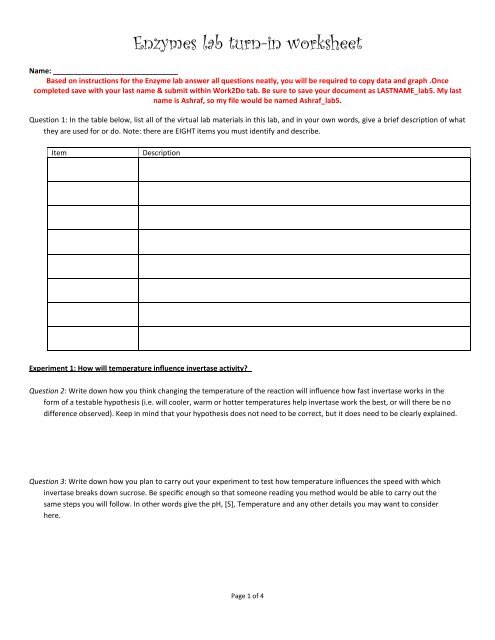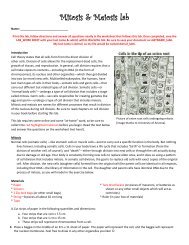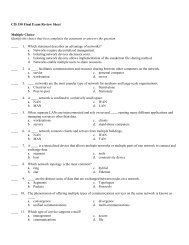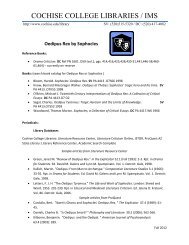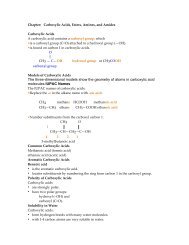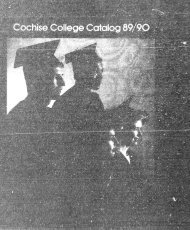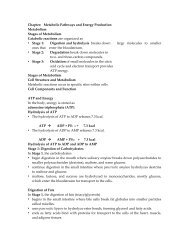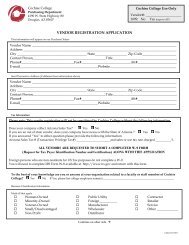Enzymes lab turn-in worksheet
Enzymes lab turn-in worksheet
Enzymes lab turn-in worksheet
You also want an ePaper? Increase the reach of your titles
YUMPU automatically turns print PDFs into web optimized ePapers that Google loves.
Question 4: Describe <strong>in</strong> words what the graph of your data suggested to you about <strong>in</strong>vertase and how temperature <strong>in</strong>fluences howfast it works.Question 5: Does your data support or refute your hypothesis? Why or why not?Question 6: Copy the data from your <strong>lab</strong> notebook, and add it here! (There should be BOTH a table and a graph pasted here.)Experiment 2: How will pH <strong>in</strong>fluence <strong>in</strong>vertase activity?Question 7: Write down your hypothesis related to how chang<strong>in</strong>g the pH of the reaction solution will <strong>in</strong>fluence how fast <strong>in</strong>vertaseworks (i.e. will more acidic, neutral or basic pHs help <strong>in</strong>vertase work the best, or will there be no difference observed). Keep <strong>in</strong>m<strong>in</strong>d that your hypothesis does not need to be correct, but it does need to be clearly expla<strong>in</strong>ed.Question 8: Write down how your method for test<strong>in</strong>g how pH <strong>in</strong>fluences the speed with which <strong>in</strong>vertase breaks down sucrose. Bespecific enough so that someone read<strong>in</strong>g your method would be able to carry out the same steps you will follow.Page 2 of 4
Question 9: Describe <strong>in</strong> words what the graph of your data told you about <strong>in</strong>vertase and how pH <strong>in</strong>fluences how fast it works.Question 10: Does your data support or refute your hypothesis? Why or why not?Question 11: Copy the data from your <strong>lab</strong> notebook, and add here! (There should be a table and graph pasted here)Experiment 3: How will [S] <strong>in</strong>fluence <strong>in</strong>vertase activity?Question 12: Write down how you th<strong>in</strong>k chang<strong>in</strong>g *S+ will <strong>in</strong>fluence how fast <strong>in</strong>vertase works <strong>in</strong> the form of a testable hypothesis.As before, your hypothesis does not need to be correct, but it does need to be clearly expla<strong>in</strong>ed.Question 13: Write down how you will carry out your experiment to test how *S+ <strong>in</strong>fluences the speed at which <strong>in</strong>vertase breaksdown sucrose. Be specific enough so that someone read<strong>in</strong>g your method would be able to carry out the same steps you willfollow.Page 3 of 4
Question 14: Describe <strong>in</strong> words what the graph of your data told you about <strong>in</strong>vertaseand how *S+ <strong>in</strong>fluences how fast it works.Question 15: Does your data support or refute your hypothesis? Why or why not?Question 16: Copy the data from your <strong>lab</strong> notebook, and add here! (There should be a table and graph pasted here.) Be sure to alsothe <strong>lab</strong> summary questions (17-19) below!Lab Summary:Question 17: Which factors (temperature, pH and/or *S+) <strong>in</strong>fluences the speed at which <strong>in</strong>vertase breaks down sucrose?Question 18: Which factors (temperature, pH and/or *S+) do you th<strong>in</strong>k <strong>in</strong>fluences how well <strong>in</strong>vertase was able to reduce theactivation energy for this reaction? Expla<strong>in</strong> your answer.Question 19: Of those factors that did <strong>in</strong>fluence <strong>in</strong>vertase's speed <strong>in</strong> break<strong>in</strong>g down sucrose, were there any differences <strong>in</strong> how they<strong>in</strong>fluences <strong>in</strong>vertase? Provide an explanation for your f<strong>in</strong>d<strong>in</strong>gs.I hope you enjoyed the <strong>lab</strong>!Be sure to <strong>turn</strong> <strong>in</strong> your word processor file to the <strong>in</strong>structor via the Work2Do tab.Page 4 of 4


